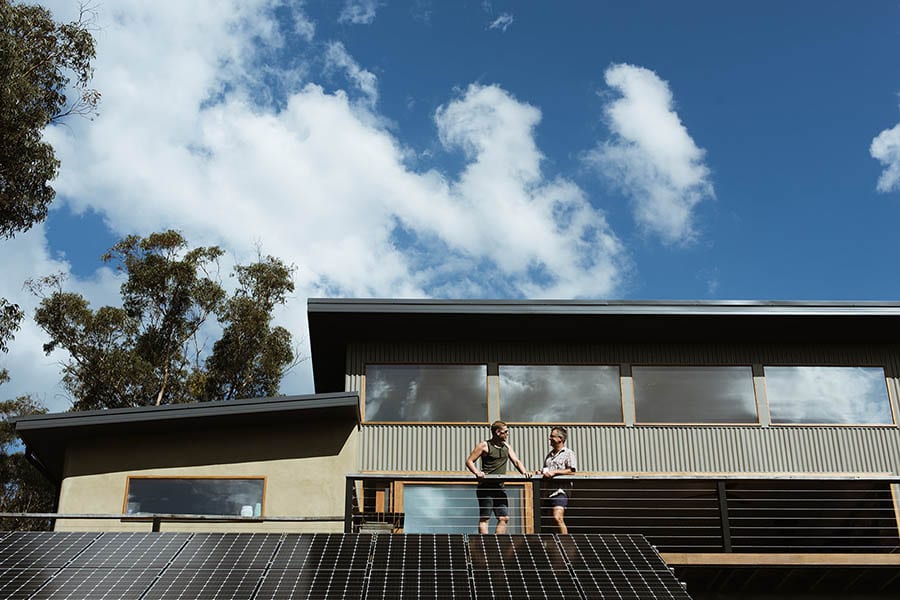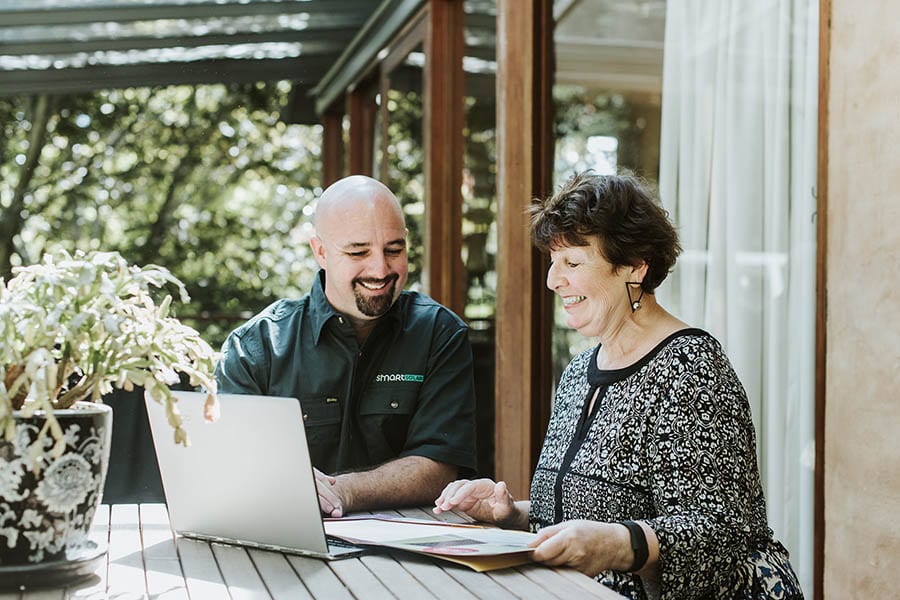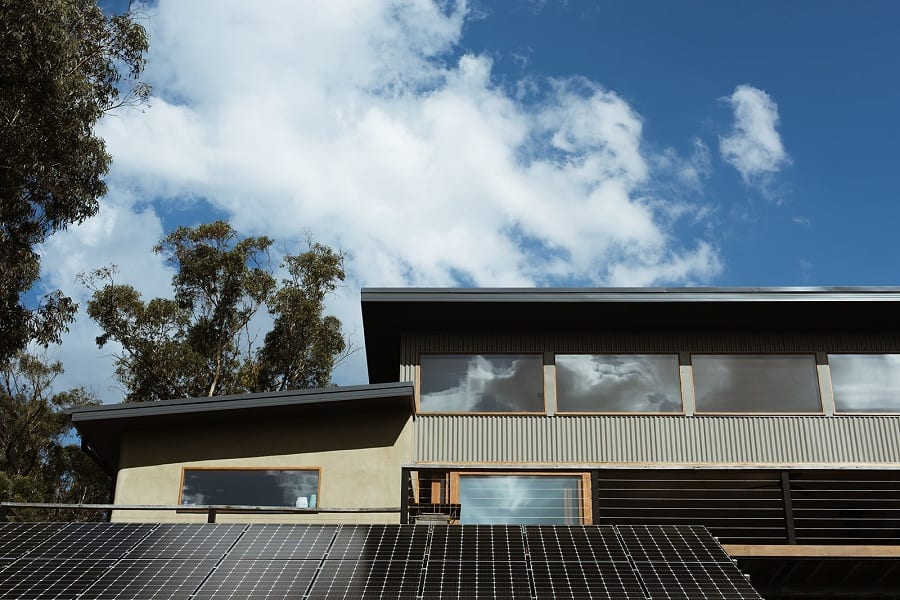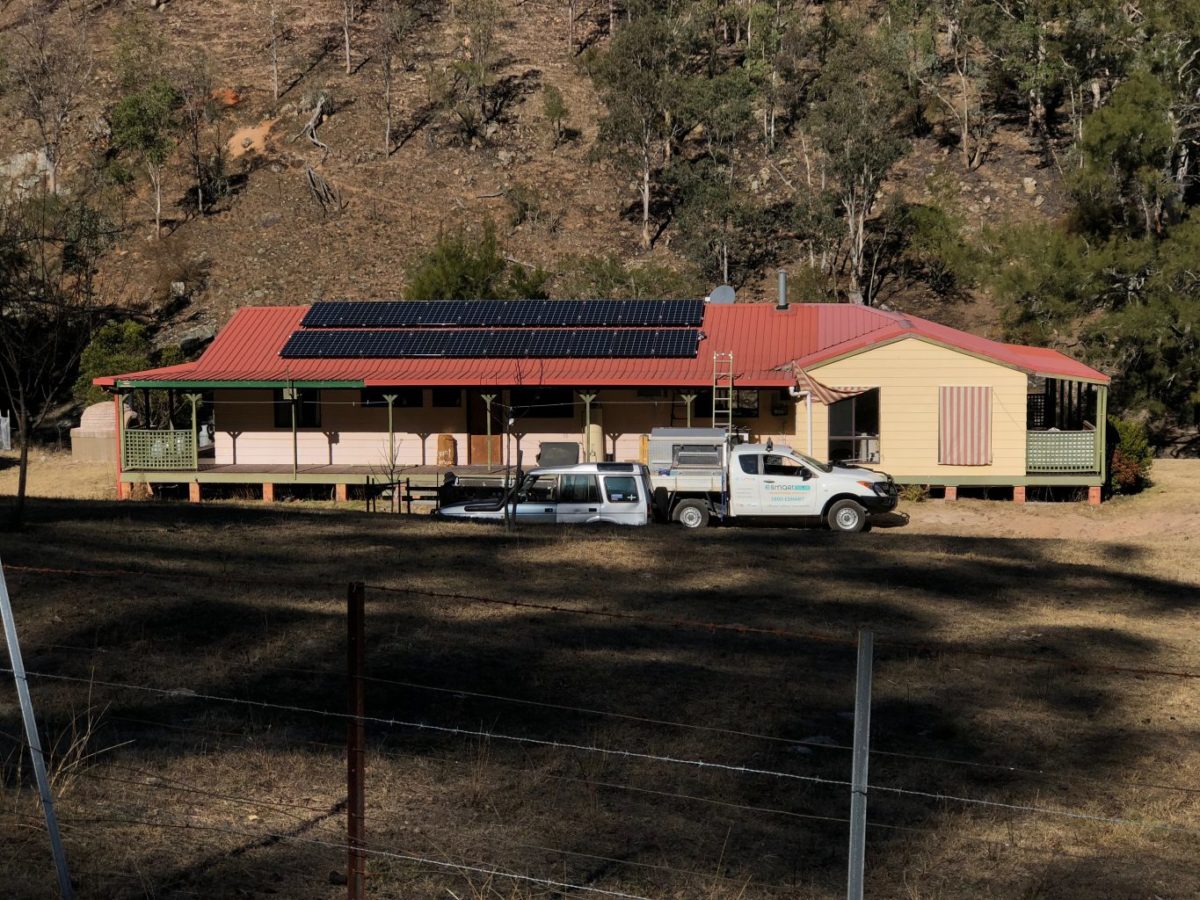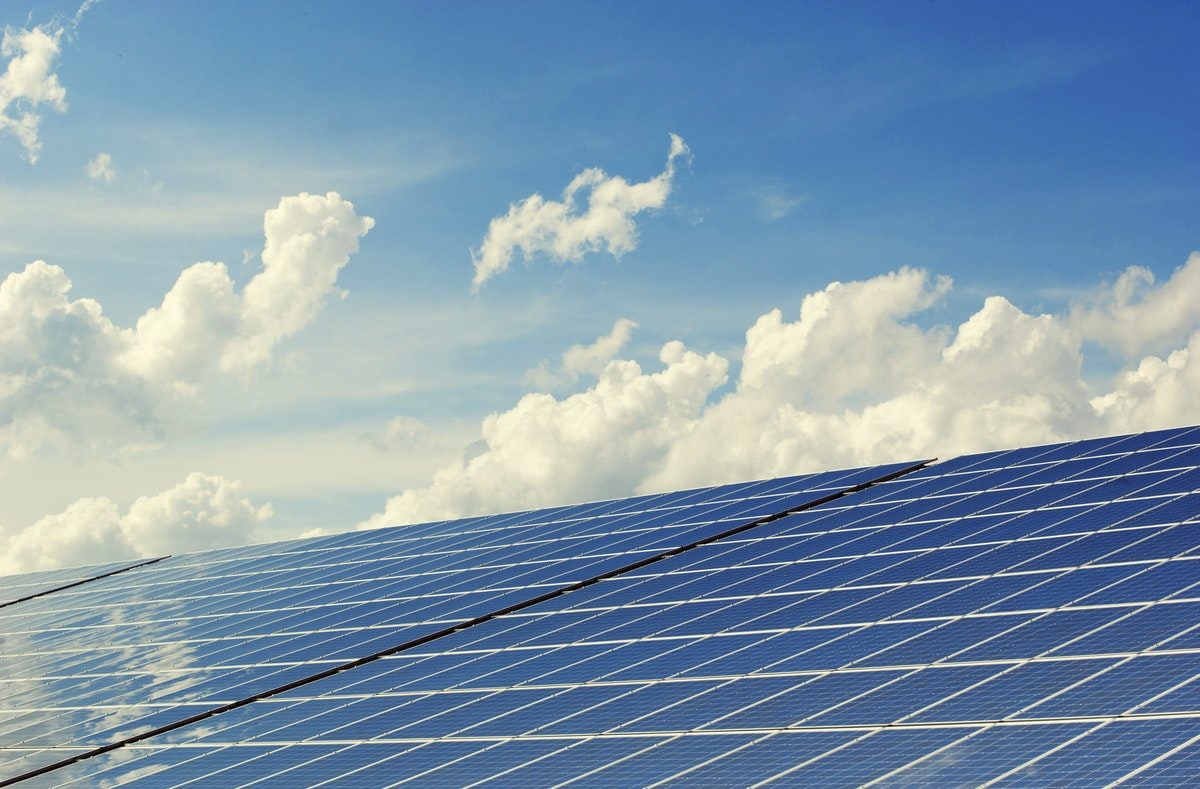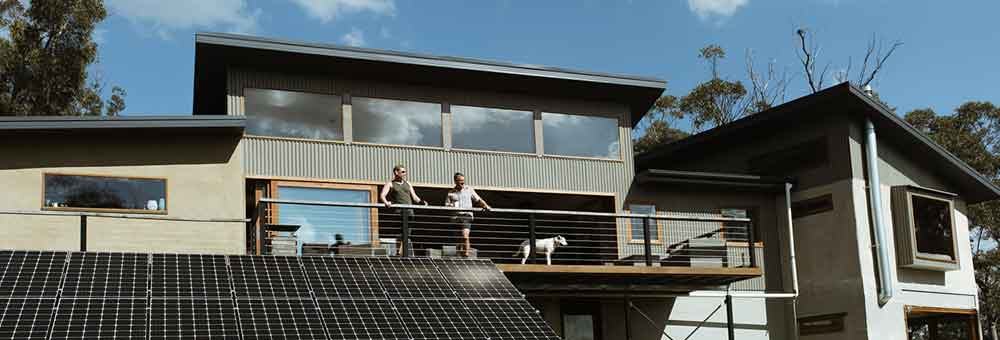Case Study: Installing a 6kW stand-alone solar energy system in Sydney’s Blue Mountains
Vanam Retreat – from generator to an off grid solar power system
Vanam Retreat is a stunning home located in Sydney’s Blue Mountains. At the time of the project, the Retreat was in the finishing stages of construction. We were asked to quote on installing a stand alone solar energy system to a site that had previously been run purely via generator. Not only was there a tight timeframe due to business requirements, but the landscape also presented an additional challenge.
We were up for the challenge, and here we talk you through how we did it.
The Blue Mountains Retreat
Situated on 40 acres of native bushland and home to native birds and other wildlife, Vanam Retreat was built using all natural materials. These ranged from straw bales and cob through to recycled timbers and earthen rendered walls.
Vanum Retreat is a home and a business. Not only do the owners run yoga retreats on the premises, but they also rent it out as a luxury airBNB destination.
The owners
Vanum Retreat owners Andrew and Jeff have been living on the Blue Mountains acreage for the last 10 years with absolutely no grid power; they’d refused to have any coal-fired power onsite due to their environmental consciousness.
In building the retreat, and making their dream of creating a truly eco destination a reality, they knew the generator couldn’t:
- Meet the needs of their clients, or
- Support the amenities they wanted to provide.
They needed a system that would enable them to be self-sufficient without affecting the landscape, both visually and environmentally.
The brief
Central to our brief was ensuring that the natural mountains landscape remain uncompromised. Because even through the retreat offers a completely luxurious experience, it also pays homage to the natural environment. Retaining this homage was critical, so we needed to integrate a purpose-designed off-the-grid solar solution with the Blue Mountains surrounds.
At our initial onsite meeting, Andy and Jeff were well researched. Both had a strong understanding of what they wanted in terms of solar, particularly in terms of size, which was:
- 6kw Solar System
- 5kw Battery Inverter
- 19kWh Battery.
The challenge
Andrew and Jeff had chosen us because of our clean energy knowledge, product transparency, and the fact that we design fit-for-purpose solutions. They also liked our can-do attitude, which was critical as additional pressure was added by a short but immovable deadline for the first week of January, as well as the complexity of Christmas shutdowns.
An additional challenge was presented by the need to integrate a man-made system into a Blue Mountains landscape without compromising the integrity of the retreat as a truly sustainable destination.
The solution – the solar products
We looked closely at their servicing needs. These included a main building with three large guest bedrooms, each with private ensuite and deck, as well as a large, modern kitchen and a spacious, open-plan indoor-outdoor living/dining room. There was also a four-bed bunkhouse and a dedicated yoga shala for up to 15 people.
We had to consider not only the power requirements for the home but also those for cooking, washing of King size sheets, and other amenities. There were also plans to increase their service provisions via an eco-powered hot tub.
As a result, we developed the following product design:
Why did we choose this combination?
Not only did we go with recommended and quality products but, vitally, products that will meet their future business plans and provide peace of mind. This product design will deliver proven reliability in an off-grid scenario so Andy and Jeff, and their clients, don’t have problems down the track with a lack of power. It will also support them as they expand their services.
The solution – the solar design
The brief was also very much focused on blending in with the unspoilt beauty of the upper Blue Mountains. The architectural design of the home maximises natural light by bringing the outside in; this openness meant that views from anywhere in the retreat couldn’t be compromised. We had to identify a critical location as well as design a solar array that blended with the earthy house and its rocky, mountainous surrounds.
The solar array had to be Northern facing to maximise productivity. With the roof Southern facing, this would have meant we had to optimise the solar panels via an installation of large tilted frames. This would give guests a not-so-delightful view of the underside of the solar panels.
To maximise productivity while also looking appealing, we designed a ground-mounted system in the garden at the rear of the house. The panels are tilted at a 30-degree angle to maximise year-round solar yield while also running in line with the natural downward slope of the mountain.
This design doesn’t impact on the views from any position:
(a) on the balcony; or
(b) from any outlook from both levels of the Retreat.
The solution – the solar installation
The ground mount system had to be extremely robust while also catering to the rocky terrain. It’s over-engineered to ensure stability, with posts in the rocky ground for the framing.
The array wiring underneath the modules is neat and follows the path of the supports to be inconspicuous.
Underground DC wiring from the solar array to the building is installed in heavy-duty conduit and encased in concrete for additional mechanical protection.
The location of the LG Chem batteries, Fronius inverter and associated switchgear are located in a separate bunker for weather and bushfire-proofing, as well as offering safety and security. (While the Fronius inverter and LG Chem batteries can be installed outside under current guidelines, the Selectronic does need to be indoors.)
The mounting board for the inverters and switchgear is standing off a besser block wall to:
- Reduce the amount of exposed conduit; and
- Keep in line with the visuals of the building.
This setup delivers protection, ensures optimum operating temperatures for the equipment, and offers longevity to Vanum Retreat’s operation.
Technical challenges we faced with the Blue Mountains off grid solar project
The solar energy system configuration
Systematically, the correct configuration and operation of all communications aspects of the system is absolutely vital to performance. With years of experience working with off-grid solar, we knew how these products worked together.
To ensure the two LG Chem batteries charge and discharge correctly, they need to operate via the RESU Plus Box and then on to the Selectonic comms card. The Selectronic inverter then needs to talk to the Fronius inverter to maximise the solar yield, but not overcharge the batteries and damage the system.
With the design of the 6kW solar array and 19kWh LG Chem storage battery, the system delivers over three days of autonomy. This means the back-up generator very rarely gets used, resulting in the site having almost zero carbon footprint.
The physical challenges of installing the solar system
Physically, the installation of the 6kw stand alone solar energy system was highly technical. We had to deal with moving large material across uneven terrain. The retreat has stone stairs and, as it was still in the construction phase, was built on a significant slope with challenging access.
Given the location, we also needed to be mindful of the natural habitat and our (literal) footprint. Aesthetics were always a priority for the client, but so was preserving the habitat for wildlife.
The ground of Mt Victoria in the Blue Mountains is predominantly filled with rock, making digging holes to install poles and overhead wires challenging. The slope on which we were working exacerbated this; digging trenches for the framework posts was both painstaking and physically demanding.
The same technical challenges came with the building of the framework; doing this on a hill that slopes quite significantly required precision and care.
What Vanum Retreat says
Of course, this is our opinion. To be completely transparent we asked Andy, from Vanam Retreat, to give us his.
“We ran a landscape design and construction business prior to opening the retreat, so we’re familiar with the client/tradie relationship and expectations. From my first contact with Dean he had a can-do attitude – we only had weeks before Christmas and I was surprised he gave me a green light.
When he came onsite, he talked me through why my idea of hanging it off the existing deck framing was unrealistic. He suggested a standalone array framework and made a call on the spot. He immediately knew the calibre of the building and what we needed to do to ensure we didn’t affect the visuals or footprint of our home.
For us, with a construction and design background, we looked at the landscape, the sun and the building. He understood that. And I love how he’s mounted it – it’s handsome, like a sail. It gives me a real sense of connection with the solar system that provides for us.
I was so impressed with the manner in which they book, do, and keep you informed. And their ability to work with me – to understand my capabilities and ability to contribute to the project – was brilliant. Dean’s ability to coordinate the last-minute framework pickup was wonderful, and we worked seamlessly to make it possible before Christmas.
Vanam Retreat was then opened for a large family group booking in first week of 2018, letting us meet our booking commitment. I couldn’t have catered to a group that large without the power, which is why we had a line in the sand with regards to requiring power for the New Year.
Dean said he would make it happen, and he did.”
The results of the Blue Mountains off grid solar project
In designing and installing this 6kw stand alone solar energy system in the rugged Blue Mountains, we developed a best practice solution for a significant solar array in a challenging environment. Not only that, but it doesn’t interrupt the serenity of the space, which was critical to the owners on a personal level.
The design benefits
What’s notable is not so much where the solar array is, but as much as where it isn’t.
It’s not mounted on the front and most visible part of the home. Instead, we’ve carefully tied the solar array into the house design. The windows are northern-facing, with the house architecturally designed to be sustainable year-round. We’ve mirrored this with the presentation and aesthetics, capturing the maximum amount of winter sun through the design.
The ground mounting ensures that the views from the home aren’t compromised. And given that it’s been designed to face the breathtaking Blue Mountains from each angle, this could have been a significant issue for the clients if not undertaken properly.
Instead, ground mounting ensures that the right size solar array was installed without compromising the entrance and first impression of the retreat, the glorious panorama from the main deck, or the spectacle visible from each of the private balconies.
The social benefits
Vanam Retreat can offer clients a stunning, luxurious and completely unique bed and breakfast destination and yoga retreat that’s 100% eco friendly.
They’ve used everything – from the construction materials through to the food they grow and cook – from the natural environment. They’re protective of their surroundings while providing a luxurious experience; one that’s usually associated with commercialism and packaging.
The environmental benefits
Environmentally, this home and business can offer service and luxury without needing an expensive connection to the main network. This connection would have involved the installation of additional infrastructure and the significant burning of coal.
The economic benefits
All running costs are removed, with Vanum Retreat using purely stand-alone power.
This 6kw off grid solar energy system has enabled them to:
- Avoid significant infrastructure costs
- Avoid ongoing power bills
- Increase the desirability of their business
- Increase the value of their home, and
- Removed reliance on a generator and the associated cost of petrol.
The business benefits
Vanam Retreat is now uniquely different by being the only destination in the Blue Mountains to offer a luxurious service with a hot tub in an eco-friendly environment.
Solar energy has also enabled them to expand their services, now taking mid-week bookings. After having completed their six-month trial of couples’ weekend stays, the couple feels confident in the system’s ability to cope with all requirements. And because solar now powers the fridges and freezers, they’re also more confident about the quality of food they’re supplying, as well as meeting the hot water and linen cleaning needs.
The yoga retreats are also expanding, with the system easily accommodating 15 guests and all of their requirements.
The system hasn’t missed a beat, so they’re stepping it up.
Custom designed solar power systems for home and business in the Blue Mountains
As this case study indicates, a good solar provider shouldn’t offer a ‘one size fits all’ solution – you want someone to take the time to get to know you, your home or business in order to understand your current and future needs.
For Vanum Retreat, we wanted to make sure that this investment was right for them and that it would meet their specific requirements.
The installation is truly representative of what solar power has to offer – in a remote location, complete and utter luxury can be provided with absolutely no cost to, or impact on, the environment.
One last word – Vanum Retreat on the 6kw off grid solar energy system
In Andy’s words:
“The solar array looks handsome. Rather than being on the roof, as the roof planes themselves are quite visual, deciding to build it separately to the house makes it look, for me, unapologetic and handsome.
People arrive and it’s there. There’s our power system – they can see how big it is, and instantly some primary equations go on in their head. Ahh, they live off the grid. It’s definable, and it’s not a compromise to the building. For me it looks like a sail – a satellite solar array in that we’re linking with the solar system/sun directly.
It really gives me a sense of that connection with the realities that we circle around, making us feel interconnected with the solar system. It’s strong and definable.
Definitely one of the many positives of the unit.”
Over to you
Do you have any thoughts, experiences or questions on off grid solar energy systems? Let us know! We’d love to hear your thoughts and answer your questions.

